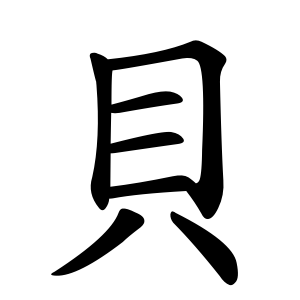貝
- clam, shell, shellfish;
Etymology
It is an ideogram (pictograph) modeled after the shape of a shell with two clam shells.
Before metal and paper money were invented, shells (specifically clam shells) were used as currency, which is why many characters containing the radical 貝 relate to money, wealth, and economics.
Usage in Korean
貝 acts as a semantic indicator related to money and valuables in many Chinese characters.
Examples:
買 (to buy)
賣 (to sell)
貴 (valuable, precious)
賤 (lowly, cheap)
財 (wealth, property)
貧 (poor)
貪 (greedy)
賃 (wage, rent)
貨 (goods, money)
貸 (to lend)
責 (to blame)
賊 (thief)
質 (substance, quality)
貯 (to store)
賢 (wise)
貢 (to offer, tribute)
Characters with 貝
10 strokes
11 strokes
12 strokes
- 貯–to store, to accumulate, to keep, to deposit, to save
- 貰–to lease, to rent
- 貴–noble, precious, valuable, esteemed, costly
- 買–to buy, to purchase
- 貸–to lend, to grant
- 費–to spend, to use up, expense, cost, fee, consumption, expenditure
- 貼–to stick, to paste, to attach, to post, to give an allowance, to be affectionate
15 strokes
16 strokes
19 strokes
22 strokes
貝
조개
패
jogae
pae
Kangxi radical:154
Strokes:7
Unicode:U+8C9D
Cangjie input:
- 月山金 (BUC)
Composition:
- ⿱ 目 八
